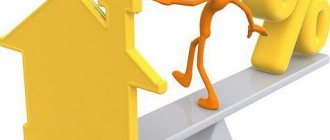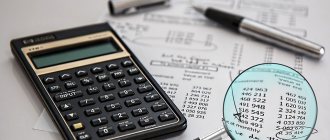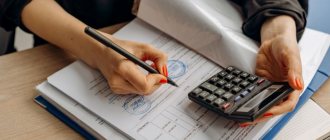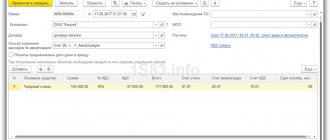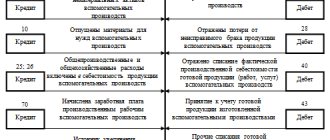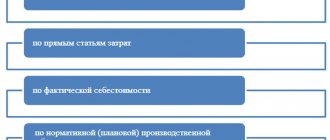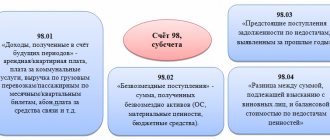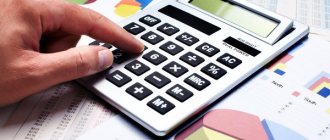Depreciation of fixed assets in accounting and tax accounting
During use, OSs lose their value due to wear and tear. Depreciation is the inclusion by fixed assets of their value over a certain period of time in finished products, works, and services.
Fixed assets in accounting and tax accounting have different criteria for classifying objects according to their value.
In addition, not all methods of calculating depreciation can be used in tax accounting. For this reason, there may be discrepancies in the amount of depreciation in accounting and when determining taxes.
For tax accounting purposes
The Tax Code of the Russian Federation establishes that fixed assets will be objects with a long service life and a price of 100,000 rubles and more.
Depreciation of fixed assets is calculated based on the original cost and the depreciation rate, which is determined based on the period of operation of the object.
Objects priced below 100,000 rubles must be shown in accounting as materials, so their price is immediately included in the cost of finished products.
The same objects that are defined as basic in tax accounting must be depreciated either linearly or nonlinearly.
The first of them involves determining the depreciation rate based on the useful life. The depreciation rate per year is calculated by dividing the unit by the useful life and multiplying by 100%. This method can be applied in tax accounting to all fixed assets.
Attention! The nonlinear method is applied only to operating systems whose application period does not exceed 20 years (group 1-7). Depreciation is determined based on the residual value of the object and the depreciation rate, which is determined for each group based on the period of use of the asset.
For accounting purposes
PBU establishes that fixed assets in accounting include objects with a price of 40,000 rubles or more. Subjects have the right to charge objects with a price less than the established criterion as expenses as materials. For objects that are priced as fixed assets, depreciation charges must be calculated.
In this case, companies and individual entrepreneurs have the right to use one of certain methods:
- Linear - by multiplying the original cost by the depreciation rate calculated based on the useful life.
- Declining balance method (non-linear) - by multiplying the residual value by the depreciation rate calculated based on the useful life.
- Proportional to the number of remaining years of use - the initial cost is multiplied by a coefficient defined as the number of years of use of the OS by the sum of the number of years of use.
- Proportional to the volume of products produced - the initial cost is multiplied by the number of products produced and divided by the planned volume of products that can be produced at the facility for the entire period of its use.
You might be interested in:
Account 60 “Settlements with suppliers and contractors” in accounting: what it is intended for, characteristics, postings
2) Method of reducing the balance
When calculating depreciation using the reducing balance method, the annual depreciation rate is determined in the same way as with the straight-line method. However, depreciation is calculated based not on the original, but on the residual value of the fixed asset at the beginning of each reporting year. The depreciation rate is multiplied by the residual value, and in turn, the residual value = Initial cost - Accumulated depreciation.
Example
Let's return to the previous example and calculate the amount of monthly depreciation charges using the reducing balance method.
The annual depreciation rate, as in the previous case, will be 20% (100% : 5).
In the first year of depreciation, the annual depreciation amount will be 24,000 rubles. (RUB 120,000 x 20%). The residual value of the machine at the end of the first year is 96,000 rubles. (120,000 - 24,000). The amount of monthly depreciation deductions is 2000 rubles. (RUB 24,000: 12 months).
Every month during the first year of depreciation, the accountant will make the following entries:
Debit 20 Credit 02
2000 rub. — depreciation of the machine was accrued for the reporting month.
In the second year of depreciation, the annual depreciation amount will be 19,200 rubles. (RUB 96,000 x 20%). The residual value of the machine at the end of the second year will be 76,800 rubles. (96,000 - 19,200). The amount of monthly depreciation charges is 1600 rubles. (RUB 19,200: 12 months).
Every month during the second year of depreciation, the accountant will make the following entry:
Debit 20 Credit 02
1600 rub. — depreciation of the machine was accrued for the reporting month.
In the third, fourth and fifth years, depreciation will be calculated similarly.
When is depreciation not calculated?
The accounting rules provide for cases when depreciation of fixed assets is not carried out:
- Depreciation is not calculated for land plots and environmental management facilities due to the fact that their characteristics remain the same over the years.
- Objects that have not been used for more than three months, that is, transferred for conservation
- Depreciation is not calculated on fixed assets received free of charge.
- If the object has been received by the company and requires installation and modification. That is, while it is listed as construction in progress (account 08), depreciation on it is not calculated.
- For objects that, on the basis of the rules established by accounting policies, are transferred to the inventory.
- For leased OS objects.
Subaccounts
Account 02 has two sub-accounts, which look like this:
- 02-1 – “AOC of one’s own character”;
- 02-2 – “depreciation of leased fixed and leased assets.”
The first subaccount records the movement of depreciation of fixed assets owned by the organization.
The second one takes into account the depreciation of fixed assets that are leased ahead of schedule by organizations, as well as fixed assets that are received on the balance sheet of the leasing recipient, if, according to the agreement, the objects are listed on his account. At the end of the lease period, the objects are transferred to the lessor, and the value accumulated on them is written off from 02-2 and entered into the correspondence of account 01.
If there is a disposal of fixed assets (due to sale, partial or complete liquidation, gratuitous transfer), the amount of accruals must be reflected according to Dt 02 Kt 01-11. A similar posting is generated in the process of writing off the amount of accrued AOC for missing or damaged OS.
Analytical accounting for this account is carried out for individual objects and groups, which are subject to accounting in the corresponding subaccounts of account 01. Through the rational construction of analytical accounting operations, it is possible to obtain information about depreciation according to the parameters that are needed to manage the company.
The procedure for determining the useful life of property
When determining the period of use of an OS object, a business entity must be guided by the following rules:
- First of all, it is necessary to use the approved OKOF classification. It is a table that lists all kinds of OS groups and the corresponding period of use. Typically the period is specified as an interval (for example, 10 to 15 years). A business entity has the right to choose any number of years included in this period.
- If an OS object is not assigned to any group according to the classifier, then it is necessary to establish the time of its use based on technical documentation or recommendations of the manufacturer (an indication of this is established by the Tax Code);
- If this information cannot be obtained, then you must contact the Ministry of Economic Development.
Attention! The established useful time must be secured at the disposal of the manager, or recorded in the transfer and acceptance certificate OS-1.
When determining the period of use for an OS that has already been in use, it is necessary to determine its period according to the group and subtract from it the time of operation at the previous place of work.
If the last period cannot be determined, then the company sets the time of use independently, but taking into account safety requirements. The law establishes the conditions under which it is possible to change the period of use of the OS after its commissioning.
This can be done in the following cases:
- Upon completion;
- When retrofitting;
- During reconstruction;
- During modernization.
Attention! The main conditions for extending the period are the fact that the characteristics of the OS object have changed so that it can be used longer than the previously determined period. However, the application time can only be extended to the previously accepted time of use.
Characteristics of account 02
To account for the amounts of calculated depreciation of fixed assets, account 02 “Depreciation of fixed assets” is used. It is passive, i.e., the calculated depreciation amounts on it are shown as a credit, and their write-offs are shown as a debit.
The account has the following structure:
- Initial loan balance - shows the amount of accumulated depreciation at the beginning of the billing period;
- Debit turnover - shows the amount of depreciation written off due to disposal of fixed assets, sale, etc.;
- Loan turnover - shows the amount of accrued depreciation;
- Final loan balance - shows the amount of accumulated depreciation at the end of the billing period.
The final balance is determined using the following algorithm: credit turnover is added to the initial balance and debit turnover is subtracted.
You might be interested in:
Account 90 in accounting: what is it used for, characteristics, examples of postings
For reliable and complete reflection of information, analytical accounts are opened for each asset object.
The balance of this account is not reflected directly in the balance sheet. The balance on it reduces the balance on account 01.
Attention! Account 02 is closed only when an asset is completely written off from the balance sheet - upon sale, liquidation, etc. Until this point, the balance should always be there and show the amount of wear and tear on the asset at the current time. The account is closed by writing off the balance to account 01 or 91.
How to close account 02 “Depreciation”
Account 02 is closed only when an asset is written off from the balance sheet, that is, when property is sold, transferred free of charge, liquidated and other disposals. Earlier than the specified moment. 02 will always have a balance, since the initial cost of the fixed asset is transferred to the company’s expenses not at once, but gradually. Since this account is passive, closing is carried out by debiting account 02 in correspondence with accounts 01 (if depreciation is fully charged) or 91 (if the object is not fully depreciated).
Conclusion - in this article we have decided which account 02 is active or passive, and how entries for depreciation of fixed assets are generated in the organization.
You can find more complete information on the topic in ConsultantPlus. Free trial access to the system for 2 days.
Which accounts does it correspond with?
From debit 02 accounting account to credit accounts:
- sch. 01 — Write-off of calculated depreciation for fixed assets retired for various reasons;
- sch. 02 — Transfer of depreciation of leased fixed assets to a separate account that has become property;
- sch. 79 — Write-off of depreciation on fixed assets that were transferred to another separate division or received from it;
- sch. 83 — Write-off of previously calculated depreciation for additional capital during revaluation.
To credit account 02 from debit accounts:
- sch. 02 — Transfer of accrued depreciation to another account for leased fixed assets that have become the property of the lessee;
- sch. 08, 20, 23, 25, 26, 29, 44, 90, 91, 97 - depreciation of fixed assets;
- sch. 79 — Accrual of depreciation transferred to other structural units;
- sch. 83 — Additional depreciation at the expense of additional capital when revaluing fixed assets;
- sch. 91 — Depreciation on fixed assets that are leased, if this is not the main source of income.
Accounting entries for account 02
See complete chart of accounts for 2022.
Account 02 is involved in the following standard transactions.
Depreciation calculation based on the degree of participation of fixed assets in the production process
| Debit | Credit | Operation |
| 08 | 02 | Calculated depreciation on operating systems used when upgrading other operating systems |
| 08/3 | 02 | Depreciation was calculated for fixed assets used in the construction of one’s own fixed assets facility |
| 20 | 02 | Depreciation was calculated for fixed assets used in the main production |
| 23 | 02 | Depreciation was calculated for fixed assets used in auxiliary production |
| 25 | 02 | Calculated depreciation for fixed assets for general production needs |
| 26 | 02 | Calculated depreciation for fixed assets for general business needs |
| 29 | 02 | Depreciation was calculated for fixed assets used in maintenance services |
| 44 | 02 | Depreciation was calculated for fixed assets used in servicing the sales process |
| 79 | 02 | Depreciation was calculated for fixed assets received from another division or transferred there |
| 91/2 | 02 | Calculated depreciation for fixed assets leased |
| 97 | 02 | Depreciation was calculated for fixed assets used in processes, the costs of which will be taken into account in future periods |
Write-off of accrued depreciation
| Debit | Credit | Operation |
| 02 | 01/Disposal | Write-off of depreciation on fixed assets that were disposed of, sold, liquidated, etc. |
| 02 | 03 | Write-off of depreciation on fixed assets that were intended for rental |
| 02 | 79 | Write-off of depreciation on fixed assets that was received or transferred to another division |
Postings on account 02
Accrued costs associated with the transfer of part of the cost of property used in the production process to finished products are reflected in account 02. This position in the balance sheet is passive. This account is characterized by the following structure:
- the amount of accumulated depreciation at the beginning of the period can be seen from the opening balance on the credit side;
- debit turnover shows the amount of the accrued amount that is written off due to the disposal of fixed assets;
- credit turnover demonstrates the amount of accrued depreciation;
- the final balance in the credit part indicates the amount of accumulated depreciation at the end of the reporting period.
The total amount of costs due to equipment obsolescence is reflected in the credit part of account 02, which corresponds with the corresponding accounts used by the organization:
Dt 20 (26.44,…)
Kt 02
If the object is leased, which is not the main activity of the lessor, then the accumulated amount of depreciation should be reflected in the following entries:
Dt 91
Kt 02
When selling, writing off and disposing of property, the cost of depreciation is recorded using the following entries:
Dt 02
Kt 01
